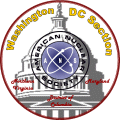
 |
Recent Past Meetings of the DC ANS Local Section |
John E. Kelly
Depty Assistant Secretary for Nuclear Reactor Technologies
U.S. Department of Energy
December 2013
Generation IV Reactor International Efforts
Deputy Assistant John E. Kelly discussed worldwide delopment participation in Genration IV reactors, from the DOE point of view. Topic covered included basic operation principals of various Generation IV reactors, as well as current construction of Gen IV reactors in China and Russia.
Commissioner William C. Ostendorff
U.S. Nuclear Regulatory Commission
October 2013
A Status Report on the U.S. Nuclear Program
Commissioner Ostendorff gave his views on current events in the U.S. nuclear power industry, from the NRC point of view. Topics covered included Operating Reactors; New Reactors; and High Level Waste.
The economics of nuclear power has been changed by the shift in the natural gas industry and the working of electricity markets, resulting in the closure of Kewaunee and the planned closure of Vermont Yankee. Crystal River and SONGS have closed because of the significant risks of major repair programs.The Vogtle and Summer projects well along in their construction programs. Several small modular reactor projects are moving ahead also.Yucca mountain is under legal review and its future is uncertain. The Waste Confidence Rule process is moving ahead, with only one major Commission decision likely to be delayed (Indian Point license renewal).Commissioner Ostendorff also answered a range of questions from the audience.
Dr.
Mark H. Whitnall
AFRRI Scientific Advisor
Armed Forces Radiobiology Research Institute
September 2013
How Does Science Work?
Dr.
Mike Corradini
ANS President
Wisconsin Distinguished Professor
University of Wisconsin-Madison
May 2013
Year
in Review -
What's on the Horizon for Nuclear?
The May meeting for DC-ANS is traditionally a time for awards, and this year was no different!
On May 7, David Ebert and Lewis Battist were recognized for 50 years with the Society. Farideh Emami Saba and Nigel Mote were honored for 25 years with the Society. Additionally, Catherine Barr, Ian Nakayama, and Henry Love and Julian Thomassie were recognized as the DC-ANS Science Fair winners (DC, Fairfax, and NOVA, respectively). They all gave an impressive snyopsis of their winning projects. After handing out the awards, Dr. Mike Corradini, ANS President, spoke about the future of nuclear power and what role ANS can play in ensuring that nuclear is an option for the US in the future. He also discussed changing the perspective for nuclear from "controlling it" to "XXX." After his presentation, Dr .Corradini answered questions from the audience about a variety of topics including the importance of energy diversity and keeping nuclear in the US' energy portfolio.
Dr.
Philippe M. Bardet
Assistant Professor
Mechanical and Aerospace Engineering
The George Washington University
Caution! Presentation file is 31
MB.
Darshak
Dholakia & Ajay Kuntamukkala
Hogan Lovells US LLP
February 2013
US
Nuclear Export Controls
and Proposed Changes on the 810
Agreement
Dr.
John E. Kelly
Department of Energy/Office of Nuclear Energy
Deputy Assistant Secretary for Nuclear Reactor Technologies
Allison
M. Macfarlane
Chairman
US
Nuclear Regulatory Commission
December 2012
On Decmeber 6, the Honorable Allison Macfarlane, Chairman, U.S. Nuclear Regulatory Commission, spoke at the DC-ANS dinner meeting. Macfarlane spoke about the Waste Confidence Decision, the status of post-Fukushima activities at the NRC, and her initial observations from her first few months at the NRC. There were over 40 people in attendance. After her presentation, Macfarlane answered questions from the audience about a range of topics including how new seismic information will affect licensees, the status of small modular reactors, and her thought's on ASME's proposed nuclear safety construct. The audience enjoyed this opportunity to get to know the new Chairman.
View remarks
Donald
Hoffman
President Excel Services & Vice President ANS
November 2012
Report from ANS & Post
Election Wrap‐Up:
What does it mean for nuclear energy?
Dr.
Mohammad Modarres
Minta
Martin Professor of Engineering
Director, Reliability
Engineering Program
Department of Mechanical Engineering,
University of Maryland
October 2012
Safety
Aspects of SMRs: A PRA Perspective
View
presentation
On October 25, Dr. Mohammad Modarres from the University of Maryland, spoke at the DC-ANS dinner meeting. Modarres spoke about the safety aspects of small modular reactors from a probabilistic risk assessment perspective. There were 30 people in attendance. During his presentation, Modarres answered questions from the audience about the design of helical steam generators, integrated reactor coolant pumps, hydrogen generation during severe accidents, instrumentation, and control room dynamics. The presentation was a great beginning to a new DCANS year.
View
presentation
By Madeline
Feltus
Approximately
125 people attended the March 13, 2012, ANS DC
Local dinner meeting to hear Masaya Yasui, Deputy Director General,
Ministry of
Economy, Trade and Industry (METI) of the government of Japan, detailed
presentation about the Fukushima
Daiichi Nuclear Power Plant Accident(s) after the March 2011 tsunami
event. Mr. Yasui is
the head of the METI
Nuclear Safety Regulation Reform section, which has the mandate to
investigate
the Fukushima accident progression, issues caused by the hydrogen
explosions,
and examine the countermeasures used by the Tokyo Electric Power
Company
(TEPCO) nuclear plant engineers to cool the Fukushima Daiichi reactor
cores,
and get the situation stabilized.
The
details provided by Mr. Yasui were very extensive and included:
accident
sequence information, details about the on-site and external power
supply
systems, containment and confinement structures’ venting,
dose measurements,
cooling system details, seismic accelerations observed, information
about the
spent fuel pool in Unit 4, and how data was obtained under the extreme
conditions during and after the initial accident phases.
The pictures of the
devastation were amazing,
especially photographs of the destruction of the off-site power
transmission
equipment and switchyard air-blast breaker insulators. The details
presented by
Mr. Yasui were fascinating and gave attendees the perspective on how
much the
TEPCO engineers had to handle during the early phases of the accident
and how
much effort it will take to restore the plant from the earthquake and
flooding
caused by the tsunami. The slides, chocked full of numerical data and
details,
provide new and more comprehensive information about the events, and
are
available on the link given here.
The attendance for this event broke recent ANS DC Local Section records for the NRC auditorium, so that the organizers had to limit the number of members signed up for the sit-down dinner hour, and request that others come later just for the presentation part. Several Japanese dignitaries and guests, NRC and DOE VIPs, and out-of-town visitors came as a result of the publicity for our local section’s event targeted towards those who were also attending the NRC Regulatory Information Conference meeting. Everyone expressed their appreciation for Mr. Yasui’s willingness to provide so much information during his presentation, and answer the many questions posed afterwards.
Steven
Freel
Vice
President/Chief Technology Officer, GSE Systems
February 2012
Simulation
and Training Solutions for the Nuclear Power and Other Industries
Summary by Kevin Witt
and Madeline Feltus
The DC-ANS Dinner Meeting on April 12
was a successful event with over 40 people in attendance. Finis
Southworth was the presenter; he is the chief technology officer for
Areva. Finis talked about the background of the NGNP program and had a
slide with the sponsors of the program. Some recent additions to the
coalition included Petroleum Technology Alliance Canada (PTAC) and SGL.
The reason for the petroleum industry interest is because of the high
temperatures used in the reactors and their applicability to recovery
of oil from tar sands in Canada. Other energy-intensive users include
petro-chemical refining, chemical suppliers, such as DOW and Eastman,
and fertilizer/ammonia companies, e.g. Potash, who would seek to reduce
their dependence on imported oil. These companies would use the NGNP
gas reactor technology to supply electricity, process heat or steam,
and collocate the nuclear plant next to their industrial
sites.
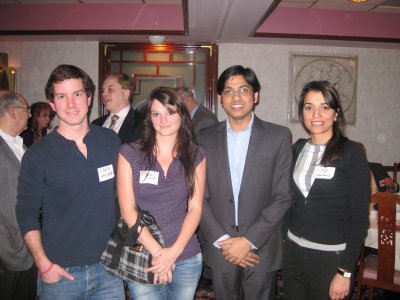 |
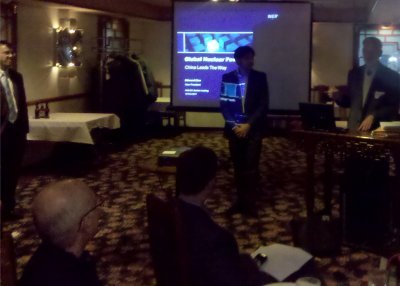 |
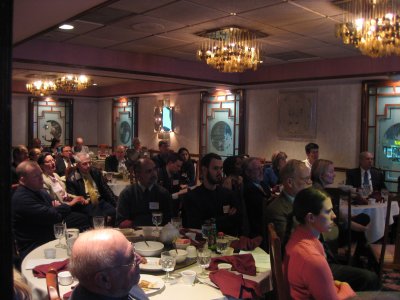 |
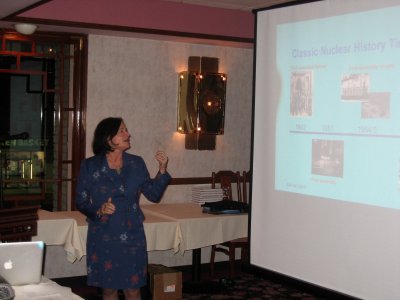 |
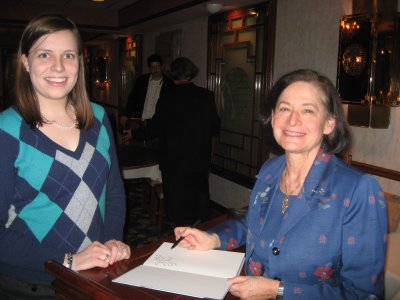 |
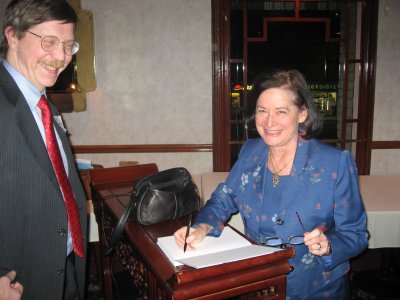 |
The
Washington D.C. Section of the American Nuclear Society (DCANS) held a
dinner meeting on Nov. 2, 2010, at the Far East Restaurant in
|
By Ray Daniels
Dr.
Hash Hashemian, President of Analysis Measurement Services in
Knoxville, TN spoke at the Washington, DC Section of the
American
Nuclear Society on October 14, 2010, at the Far East Restaurant. Dr.
Hashemian described the DOE government program to stimulate R&D
for
companies with less than 500 employees. The program is
divided
into three phases. Phase I is < $0.5 Million, Phase II is
< $1M,
and Phase III is < $3M.Analytical Measurement Services is a boutique company for analyzing data. Their clients are nuclear power plants (NPP) in the USA, Spain and Korea. Dr. Hashemian characterized NNP as having buried treasure (data) which can be used to improve reliability, availability, and productivity. AMS uses instrumentation, visual inspection and acoustic monitoring as sources of data for control purposes and as diagnostics for corrective |
actions
and for calibration. Results of AMS analyses are used for
predictive maintenance based upon neutron radiography, vibration
analysis, analysis of lubricants. His specialists use data
from
temperature, pressure and neutron flux for prediction of time
to
failure for components. He gave examples of sensing line blockage in valve piping by plotting amplitude versus frequency. Core barrel vibration in boiling water reactors was analyzed using this method. Wireless sensors available in reactors containments can be used to obtain real time information and are being evaluated by ASME under Section XI. Monitoring of impedance of cable connections can be used for useful information. A lively question and answer period ensued. |
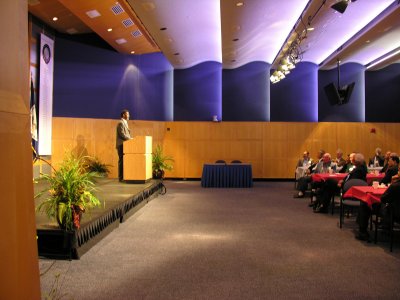 |
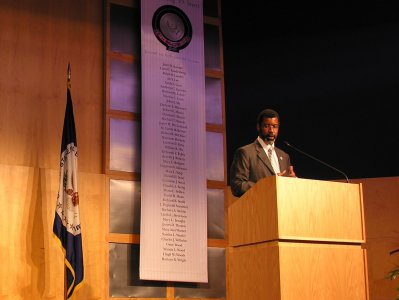 |
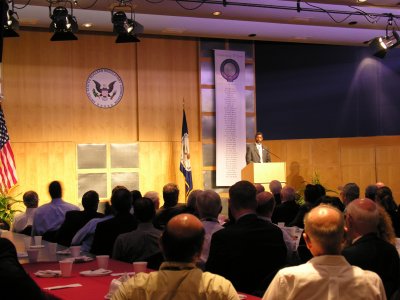 |
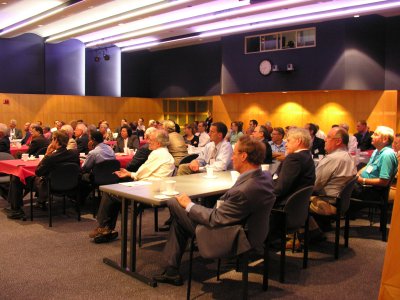 |
| The
new program year for the ANS Washington DC Section got
started
September 15 with a very successful dinner meeting hosted by the
NRC. After a bountiful buffet dinner of chicken parmesan,
Italian
pasta and the works, the joint ANS and HPS crowd of over 80 people were
fortunate enough to share a bit of wit and wisdom from NRC Commissioner
William Magwood. The Commissioner started with a few of the
highlights of his career, including his work as the Director of Nuclear
Energy with the U.S. Department of Energy where he led the creation of
the "Nuclear Power 2010" initiative and his early days as a scientist
for Westinghouse in Pittsburgh. He then shared that shortly
after
he cut back his consulting schedule, he was asked to serve as a
Commissioner. Although he was initially reluctant to take on
such
a demanding assignment, his dedication to public service won out, and
he has spent the past 6 months adjusting to his new role at the
NRC. He compared his experience working with the DOE to his current role as a Commissioner at the NRC, and noted that the cultures within the two agencies are very different. Showing his sense of humor, he likened the DOE operating mode to a state of chaos, with a vast range of activities underway at anytime, while the NRC is the most disciplined organization he has ever seen, maintaining a steady focus on establishing policies to ensure nuclear safety. His success in both organizations demonstrates his flexibility as an executive. Upon reflection of why NRC has repeatedly been ranked as the “best place to work” in the federal government, he noted the extra management attention on the career paths of the staff as a significant difference that surpasses what DOE typically provides as a probable factor. He purposely kept his presentation short so that he could allow the audience an opportunity to ask questions, and the audience didn’t hold back. Although one or two questions were too politically sensitive to address, the majority of them provided the basis for a very interactive discussion on current nuclear issues. Some of the questions that were asked and the answers the Commissioner provided are below. 1. The nuclear workforce is changing, and most of the experienced NRC staff who reviewed the license applications for the current fleet of reactors have either retired, or will be retiring shortly. Who is going to review the license applications for the new reactors? While it is true that many of the experienced professionals at the NRC are retiring, it should be noted that the NRC has very high standards for hiring the very best engineers and scientists from well-known, accredited universities. In addition, the NRC has established various knowledge-management and mentoring programs to collect and share the expertise of its professionals, as well as extensive training programs to bring new employees up to speed quickly. These and other, similar programs are ways that the NRC is actively involved in “growing the expertise” from within the agency. The National Labs may also play a role in ensuring safety for the new generation of reactors. In short, it will be just like NRC did the first time, back in the 70’s. |
2.
In the past, NRC Commissioners have had the tendency to select one or
two issues or areas for special focus during their term - is there any
particular issue or area that you hope to become involved in
shaping? Although he intends to be involved in all of the
current
issues before the Commission, he is strongly interested in supporting
educational programs, and hopes to be able to make an impact in this
area. His recent experience in talking with American high
school
students revealed a serious lack of interest in technical
subjects. He also stated some current statistics regarding
high
school graduation rates that were alarming when compared to the era
when he graduated. 3. What is the status of the Blue Ribbon Commission (BRC) the president selected to review the high-level waste disposal issue? Has the Commission been informed of any developments or plans? This question comes from a highly political realm, but the simple answer was basically no, the NRC Commissioners have not met with the BRC or been briefed on their activities, although some NRC staff have interacted with the BRC to provide information on spent fuel and high level waste. 4. The nuclear industry is global, with a majority of the growth being overseas. Many of the new plants in the planning stages will be built in countries that do not currently have nuclear power, and in many cases do not have the resources necessary to establish a highly effective regulatory program. Furthermore, an accident at an international plant would impact our industry for years to come. What is the NRC doing to help train international regulators to ensure a high level of safety is maintained in the global industry? There is already a significant amount of collaboration between the USNRC inspectors and personnel from regulatory bodies in other countries. This includes staff exchanges, meetings to establish international safety standards and temporary assignments with the IAEA. However, given the importance of maintaining the industries’ excellent nuclear safety record to the growth of the worldwide nuclear industry, Commissioner Magwood agreed this might be an area for further exploration. He may consider greater sharing of resources for training international regulators, such as assigning US inspectors in overseas plants and providing standardized training at the NRC for regulators from other countries. Please note this is just a tidbit of the lively discussions at the meeting. Be sure to attend the next meeting in person to get the “rest of the story,” as Paul Harvey would say! Thanks! - Kevin |
| For
information on past meetings from April 2010 and before. |
| Last revised 5/15/13 | DC ANS Home |